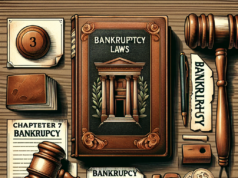
The range of
experiences that brings people in debt before United States bankruptcy courts
is captured and contained within a mere six chapters of the Bankruptcy Code.
Expectedly, the individual is well represented, as considerations are made for
his or her income level, and in some cases, his or her profession (to which
their salary may be tied), if such a thing even is applicable.
With
amendments to Federal bankruptcy law from the transition to the 20th century
and onward, groups gained clear rights to be protected under Title 11 of the
U.S. Code. Not only did considerations of the “debtor” extend to
private and public agencies, but even beyond the boundaries of the United States
itself. Thus, though bankruptcy is not to be encouraged and is on the rise for
many populations, the fact that American bankruptcy law is one of the law’s
more forgiving subsets is a redeeming quality.
Liquidation (Chapter 7)
The decision to file for Chapter 7 bankruptcy may
be one of reluctance for debtors, but all the same, they might not be left with
much of a choice if they are unable to manage their debts and cannot come up
with a reliable repayment plan. Chapter 7, also known as liquidation, works by
identifying assets of individuals and companies that may be sold to offset
debts. Certainly, debtors and their properties must be eligible to use this
method of debt relief and may not try to use illegitimate means such as
misinformation to secure benefits under Chapter 7.
Although
most of the time a petition for a liquidation case will be voluntary, creditors
may specifically request this action to force the sale of debtors’ possessions
to regain at least something from their broken investment agreement. For the
willing applicants, however, Chapter 7 bankruptcy is more of a
“do-over” whereby, with the unfortunate consequence of a lower credit
rating, debts may be pardoned (“discharged”). Unlike most other forms
of debt adjustment, it is specifically not a repayment plan.
In filing for Chapter 7 bankruptcy, debtors are
advised to get several things in order. First of all, there are a number of
forms containing key financial information about debtors that must be presented
to the court, namely that of their lenders and loans, their income and
expenses, and any executory contracts to which they are a party. Not only must
the judge be appeased that a case warrants court consideration, but the
creditors must also be presented with a satisfactory plan that will override
existing contracts and create new target amounts for debtors to reach with the
sale of their assets.
Secondly,
certain events must be heard in a court setting. This includes the actual
meeting of the creditors in which the petitioning party will be interrogated as
to the specifics of their plan, as well as the hearing in which these matters
will be confirmed. Though not required, a licensed bankruptcy attorney who
knows about Chapter 7 protocol is certainly a prudent hire for the debtor with
means. Thirdly, debtors must prepare a list of all of their available assets,
making due distinctions between exempt and non-exempt assets. Usually, the
latter category responds to retirement funds and other public benefits.
Municipality Reorganization
(Chapter 9)
Chapter 9 municipality reorganization is a
departure from the “fire sale” approach to canceling out debt that
epitomizes Chapter 7 bankruptcy. Instead, as it is a whole city or other
district of a comparable size that must be rehabilitated (and logistically, it
is unfeasible for an entity that large and with so many residents to be
liquidated), a qualifying municipality (e.g. village, town, county, city) must
try to manage its existing debts to move out of bankruptcy and survive
financially. In doing so, it must still get approval from creditors and the
court, but it is not subject to the same level of scrutiny as debtors within
proceedings of other chapters of the Bankruptcy Code.
As Chapter 9
law specifically states, the courts may not impair the day-to-day affairs of
municipalities to try to overcome their debts. In fact, as a plan is
implemented, municipal debtors may have the latitude to even take out new
loans.
While minimal contact may be had with creditors
and courts before and after the fact, municipal debtors have significantly more
responsibility to engage the members of their community. Not only must they put
notice in a major newspaper in the community, but they must allow the community
ample opportunity to present their stance on the issue prior to moving forward.
Chapter 9
municipal applicants also have a responsibility to tell the truth for fear of
more intensive action on the part of the courts, and in a more adversarial way.
Any petitions not made in good faith or devised in a way that is not equitable
for all creditors may find they are dismissed before long, though there is not
a great deal of precedence for this. Then again, there is not a great deal of
precedence for the use of Chapter 9 at all. On an annual basis, it receives the
least petitions of any form of bankruptcy within the U.S. Code. Still, this
causes examples of Chapter 9 cases to stand out all the more. In the State of
California in particular, the Chapter 9 filings of the City of Vallejo and
Orange County (the largest bankruptcy in American history) are potent symbols
of the ease at which vast debts can be accrued.
Reorganization or
Rehabilitation (Chapter 11)
Though of course not of the same scope
geographically as Chapter 9 proceedings, Chapter 11 business reorganization
cases, especially when happening around the same time as one another, can have
a potentially crippling effect on the economy, as millions in debts and
billions in assets may be at stake. As with Chapter 7, Chapter 11 bankruptcy is
a legal possibility for individual and corporate debtors, though far more
likely for the latter, who have naturally higher amounts of debts and more
assets to manage. Even sole proprietors and partnerships may be part of the
proverbial mix when it comes to Chapter 11 court matters, and effectually,
almost become Chapter 13 debtors in how the laws are applied.
Comparable
to Chapter 7, creditors may initiate the discussion of filing for bankruptcy.
Much in the way that debtors will file for bankruptcy to keep creditors at bay,
creditors will use these proceedings to force the issue regarding delinquent
payments.
In all, though, the primary focus tends to be
placed on debtors, both in what responsibilities they are asked to fulfill, and
what benefits they stand to reap as a result of them. The biggest point of
deviation in the role of the debtor in Chapter 11 proceedings is that, under
most circumstances, there will not be any additional officer as a trustee. The
debtors themselves will serve this purpose, addressing the concerns of
creditors and keeping up with the courts through the filing of regular reports,
among other duties.
Nevertheless,
Chapter 11 bankruptcy offers debtors some distinct advantages. For one, courts
allow corporate debtors the first opportunity to issue a reorganization plan.
Perhaps the greatest of these overt opportunities, though, is that businesses
will be permitted to remain open while they restructure. Potentially, they will
capitalize on the provision of automatic stay (or as some insist, abuse it) and
aggressively drive down the rates of their service, being rewarded for their
failure to meet their debts. It is these kinds of special privileges afforded
to some high-profile Chapter 11 filers and/or the ill effects of their
mismanagement and need to reform (e.g. store closings, lost jobs) that have
made them famous amongst the American general public. Names like “Lehman
Brothers” and “Enron” are likely to be met with bitterness by
many people for their filing for Chapter 11 bankruptcy and the eventual
revelation of their misdeeds.
Rehabilitation or Organizations
for Farmers and Fishers (Chapter 12)
As with Chapter 9 and Chapter 11 bankruptcy,
Chapter 12 is not going to serve much of a purpose for the average American.
For farmers and fishermen who are trying to keep their family business alive,
however, Chapter 12 bankruptcy relief is going to be more relevant. Chapter 12
filings must come voluntarily from debtors and there are certain specific terms
of eligibility built into this chapter’s protections.
As with
Chapter 13 bankruptcy seekers, individuals who file under Chapter 12 must be
earners of a regular wage, must do a significant amount of business in the area
of farming or fishing, and their debts must not exceed equally specific maximum
tallies that vary with regard to their trade. Over a period of three to five
years outlined by the courts, debtors under Chapter 12 must try to repay
creditors based on their priority, secured and unsecured claims.
Special
considerations are made for family farmers and fishermen given circumstances
largely beyond their control. If the bulk of their income is gained from one
season of the calendar year and/or some deleterious happenstance impairs their
ability to consistently bring in money throughout the year, the courts may show
mercy on applicants, even affording them a discharge of debts in light of their
hardship.
In terms of American history, Chapter 12
rehabilitation for farmers and fishers only just became a lasting institution
in this country. Going back to reforms of decades and centuries past, the most
substantial amendments to U.S. bankruptcy law were those that were developed in
direct response to crises facing the farming industry (binding, lasting
provisions for relief for both family farmers and fishermen were not enacted
until the Bankruptcy Abuse Prevention and Consumer Protection Act of 2005).
The
Frazier-Lemke Act, after it was modified and found to be constitutional against
the Fifth Amendment, was a symbol of the commitment of the New Deal to prevent
honest, hard-working Americans from losing their homes and businesses. Decades
later, the desperation of farmers was renewed with ailing land values and
plunging worth of agrarian commodities, and the Bankruptcy Judges, United
States Trustees and Family Farmer Protection Act of 1986 intervened to first
officially add Chapter 12 to the Federal register, though only as an emergency
measure.
Payment Plan Rehabilitation for
those with Regular Income (Chapter 13)
Chapter 13 is sort of a middle ground between the
harsh penalties of Chapter 7 liquidation (i.e. permanently losing some
possessions, suffering damage to one’s credit rating) and Chapter 11
rehabilitation measures for individuals. As opposed to a wholesale forfeiture
of rights to personal assets to cover one’s debts, Chapter 13 debt adjustment
is designed to entertain the retention of these most important assets as
bankruptcy judges, trustees and creditors look toward future sources of income
in trying to absolve debtors of their financial obligations.
There are a
number of distinct advantages to applying for Chapter 13 bankruptcy. As with
Chapter 12 bankruptcy for family fishers and farmers, repayments under Chapter
13 plans are spread out across as long a span as five years. Also like Chapter
12, debt adjustment plans will be given leniency in the event some calamity
befalls the debtor, notably a personal injury or severe illness. Plus, in cases
of shared financial obligations for which debtors are currently delinquent, not
only may a principal debtor be afforded a stay from collections, but co-signers
may also be protected from attempts of lenders to liquidate their assets and
satisfy the money that is owed to them via the original service contract.
Perhaps the most critical of advantages of Chapter
13 over Chapter 7 bankruptcy in particular is that homeowners may be able to salvage
their estate when filing for Chapter 13, whereas with Chapter 7 bankruptcy, the
debtor’s route may be one of foreclosure or sale of the house by request. In
broader terms, this avenue provides a fresh start for Americans suffering under
the burden of their debt.
Just the
same, there are other practical factors to take into mind when declaring one
way or another. Chapter 7, for one, permits less overall conditions for
discharge, yet allows for an easier discharge of debts than Chapter 13 (of
course, this assumes the court recognized that a debtor’s case even belongs in
Chapter 7). On top of this risk-reward binary with Chapter 7, Chapter 13
individual debt readjustment still requires its petitioners to pay taxes and
domestic support and will also involve drops in credit rating and regular
payments to the office of the trustee to relay to creditors as enumerated in
the rehabilitation plan.
Cross-Border Insolvency
(Chapter 15)
When disputes over debts to be repaid occur in
multiple countries, Chapter 7, Chapter 9 and Chapters 11 through 13 of the
Bankruptcy Code are not sufficient in themselves to coordinate court activities
across jurisdictions, though they may eventually become involved. In contrast,
Chapter 15 bankruptcy was expressly created in response to natural difficulties
is reconciling procedural/legal standards between countries.
In its
insistence on harmony and community unification amidst its goals of getting
debtors the most bang for their buck, so to speak, in liquidating their assets
and restructuring their businesses, Chapter 15 cross-border insolvency is
clearly based on the underlying principles of the United Nations Commission on
International Trade Law, and has a lineage in Section 304 of the 1978-era
Bankruptcy Reform Act as well as a debt owed to the 2005 BAPCPA for its
creation.
Broadly, Chapter 15 is meant to govern good
communication between interested parties in different countries and allow
foreign officers to use American bankruptcy courts to their own ends. As for
specifics of Chapter 15 bankruptcy law, the role of the foreign representative
is a major one, as they may be called in for any range of activities the debtor
needs, such as getting a hearing abroad recognized as one that also would
satisfy U.S. laws, advocating for the best relief for applicant parties, and
managing estates in the event applicants are unwilling or unable.
Yet more
narrowly, especially in the event of multiple filings abroad or concurrent
cases, it must be decided in which court the “foreign main
proceeding” will take place, and thus, by which standards any means of
relief should be assessed (in pending Chapter 15 cases concerning holdings in
the United States and overseas, usually American Federal standards which will
prevail).











